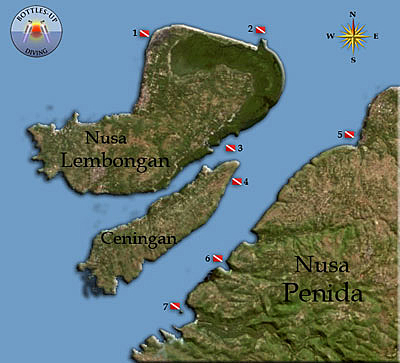Nusa Lembongan and Ceningan channel
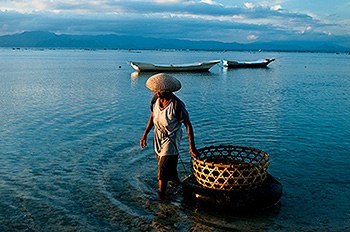
Nusa Lembongan - Nusa means island in the Balinese language - is situated 20km south east of Bali.
The islands Lembongan and Penida can be reached from Sanur and Padangbay.
It is approximately 20 minutes by fast boat; either from Padangbai or Sanur to Nusa Lembongan.
Nusa Lembongan is the most popular of the 3 islands across the Badung Strait and is connected to the smaller Nusa Ceningan
by a small bridge.
This small island has several thousand locals who live from seaweed farming, fishing and tourism.
The island is only 4 kilometres long and 3 kilometres wide. A walk around the island will take up to 5 hours and is quite a challenge.
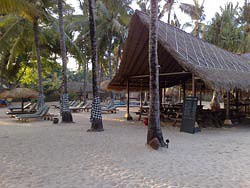
There are possibilities to rent a bicycle or motorbike and take a tour around Nusa Lembongan and then cross the bridge to Nusa Ceningan.
There are great views of both Ceningan channel, Lembongan and Bali from the top of Nusa Ceningan.
The village life is very traditional and the atmosphere around the island is enchanting.
Unlike mainland Bali you will find just a few cars and motorbikes around which doubles the relaxed atmosphere. Although the last 4 years the island has become very popular and many new accommodations popped up, especially at Jungutbatu beach.
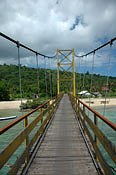
Nusa Lembongan offers some very nice beaches for swimming and sunbathing in the South west - mushroom bay and dream beach - and some good surfing just in front of the main village.
The dive sites are all located at the Northern corner of the island.
There are lots of small places to stay at the Jungutbatu beach which is favorite with surfers and divers alike.
The more luxurious places to stay are further south towards Mushroom Bay, where many of the day-trip cruise boats stop.
When you want to visit Nusa Lembongan during the high season you need to book in advance - 2016 - and we can help organise your trip.
Dive conditions Nusa Lembongan
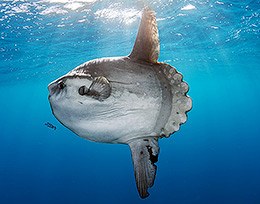
The south of Bali is known for its current swept dive sites around the islands.
This area is famous for the Mola-mola, or Oceanic Sunfish, especially from July until October you will have a 90% chance to see them at the dive-sites
Crystal Bay and Blue Corner.
Other animals like Tunas, Marble Rays, Sharks and Manta Rays can be found over here.
Most dive sites have often very strong and unpredictable currents and undertows which make this more suitable for more
experienced divers.
Due to up welling water from the deep the temperature can be uncomfortably cold, 23°C or less, but it also provides good visibility!
Here is a detailed map of the water depths around the islands.
Sea depths around Nusa Lembongan - Ceningan and Penida
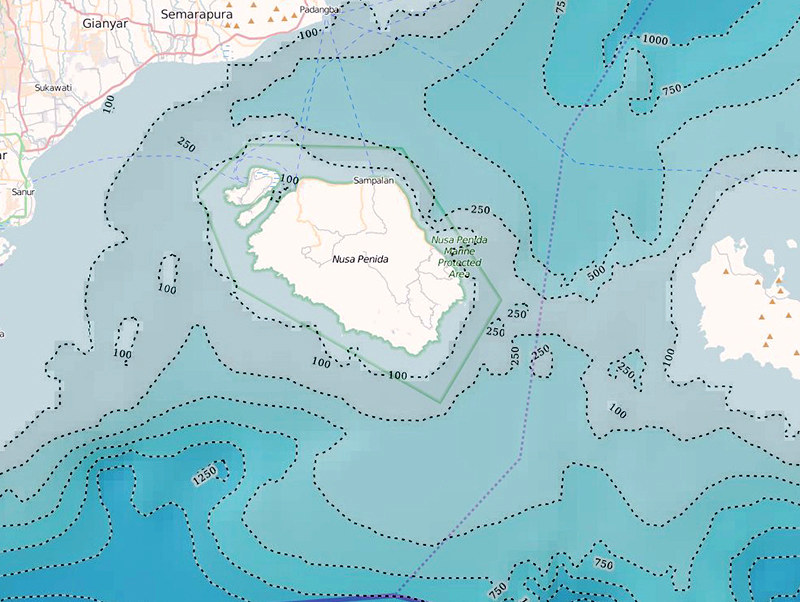 © www.openseamap.org
© www.openseamap.org
Most dives sites are to the North around Lembongan and Nusa Penida and in the channel between Nusa Ceningan and Nusa Penida.
Shark numbers are decreasing at a shocking rate.... What all people, especially divers, should know about the shark population.
Shark population
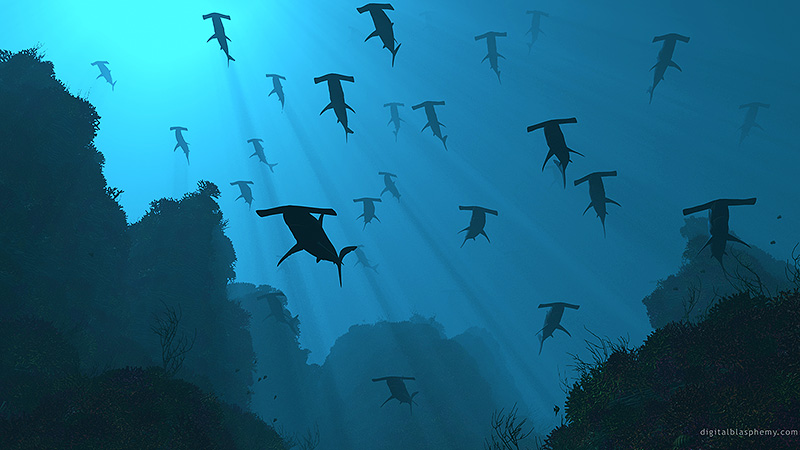
Most divers would love to see sharks, but should realize that there is a great slaughter amongst these apex predators happening every single day.
Indonesia ranks number 1 on the list of top 20 shark catchers.....
Diving in 1995 in the Bunaken national park we encountered sharks every dive. When we went back in 2008 we saw maybe 5 sharks on a total of 60+ dives!
When describing dive sites, we often mention that you might see sharks, but every year the chances are less..
An estimated 100 million sharks a year are killed, mostly for shark fin soup, says a shark researcher of the University of Windsor.
These are the shocking results done by the Institute for Environmental Research published in March 2013 in the journal Marine Policy.
The postdoctoral researcher, Steve Kessel, was part of this research team that came up with a more comprehensive estimate of the number of sharks being killed each year.
Due to the incomplete nature of the data for shark catches, that number could be as low as 63 million or as high as 273 million, but both the high and low end estimates are
considered outside of safe biological limits.
The study also found shark populations cannot reproduce fast enough to overcome that death rate.
There are about 400 species of sharks and 28% of them are threatened by extinction, Kessel said.
“One in every 15 sharks is taken every year”.
The Top 20 shark catchers in descending order are:
Indonesia, India, Spain, Taiwan, Argentina, Mexico, United States of America, Malaysia, Pakistan, Brazil, Japan, France, New Zealand,
Thailand, Portugal, Nigeria, Islamic Republic of Iran, Sri Lanka, Republic of Korea, Yemen.
Sources UNFAO, TRAFFIC 2013
Indonesia and India are responsible for over 20% of global catches between 2002 and 2011. Three EU Member States: Spain, France and Portugal, are among the top 20 shark catchers, responsible for 12% of global catches. Collectively, the 28 EU Member States are the largest shark catching entity of all.
Major hotels that continue to serve shark fin soup include:
Ritz Carlton-Hong Kong
Nikko hotels throughout Asia (headquartered in Japan)
Regal Hotels in Hong Kong
Prince Hotels and Resorts in Japan
InterContinental Group, a UK-based company
This list was comprised in conjunction with Wildlife risk.
Dive sites Nusa Lembongan
Use the map to jump to the dive site :Blue Corner - [1]
This site, also known as "Lighthouse" consists of a slope with plateaus on various depths, starting with the
first on 20 metres.
The slope goes down to 50 metres. Depending on the tide the current varies from light to very strong this can be
quite dangerous.
When you are diving you must reach the first plateau at 20 metres this might take some effort, but it is worth it!
If there is current there are lots of Rays, schools of Snapper and Jacks.
In season the Mola-mola might be seen here. White-tip reef sharks are seen here often.
We love this site, but with strong currents this site is for experienced divers only!
Jangka / Mangrove point - [2]
The Mangrove forest offers a healthy sloping Coral reef with small bommies and Table corals. A lot of juveniele fish and other marine life around in the shallow part of the dive.
During the dive you most probably will encounter a large variety of fish like Triggerfish, Angelfish and Banner fish.
In deeper water Sharks and Eagle rays are occasionally seen here.
When the currents are strong this beautiful drift dive is for the more experienced divers.
Ceningan Channel - [3]
The standard reef profile here has a reef terrace around 12 metres, then a wall or steep slope up to 30
metres, then a fairly gentle slope to the sea bed at 100 metres! Enjoy the beautiful colours of the soft Corals and schools of fish.
This is a nice drift dive suitable for all levels of divers.
Ceningan wall - [4]
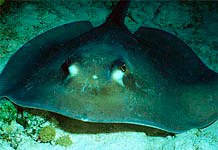
This site is for experienced divers since it has unpredictable currents and slopes to unlimited depths.
Visibility is good and the wall has orange soft Coral and Sponges. The water temperature can be as cold as 23°C. These waters are
rich and nutritious also because of water flowing out of the mangroves.
There are schools of Oriental sweetlips, Triggerfish, Surgeonfish and Rays to be seen.
Leopard sharks and Mola-mola's have been spotted on this site.
When the time is right, in our case October, the Mola-mola comes up rising from the deep, see our video of a Mola mola encounter.
Toyapakeh - [5]
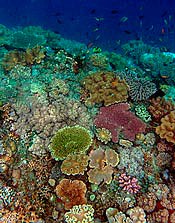
One of the best drift dives in this area because of the beautiful Coral and good visibility up to 30 metres.
This site is on the Nusa Penida side of the bay, and has a depth between 3 and 37 metres or deeper.
At a depth of 24 metres you can drift over fields of Corals, totally beautiful. An abundance of small tropical fish and on a good day
you might see Mola-mola's, Manta's and even Hammerhead sharks - we have not seen them....yet!.
Gamat bay - [6]
This site starts beautiful with a colourful carpet of Corals where you can find Nudibranch and big Groupers.
Leaving the gentle waters of the bay the current takes you drifting along the wall of the channel. Conditions are the same as the site Crystal Bay so be prepared for down currents. Keep one eye to the channel for Sharks and Mola-mola's.
Crystal bay - [7]
We describe the site here, but the bay is actually situated in Nusa Penida. This small lagoon has a nice white sandy beach and the visibility underwater is amazing. Water temperature is cool.
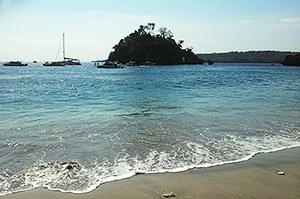
This site starts in the bay which is nicely sheltered from the current, but the minute you leave the sheltered bay to enter
the steep slope, the current picks up and might change into a down current!
Since this channel is deep, depths greater than 50 metres, know how to react in case of a down current.
The hard coral reef starts at 5m, has a white sand base, and is covered with Anemones and soft Corals.
Marine life includes Angelfish, Sweetlips, Frogfish, Banded sea snakes and many Moorish idols.
We went out the lagoon into the channel passing the small island and entered the lagoon on the other side again. After too many accidents in the channel many dive-operators are not going around the island anymore, but go just around the corner to have a look into the blue for Mola mola's.
Dive-site Crystal Bay, especially when you go into the channel, is for the experienced diver. The wall has beautiful Corals and here we saw our first couple of Mola-mola's.
Bali's dive locations

